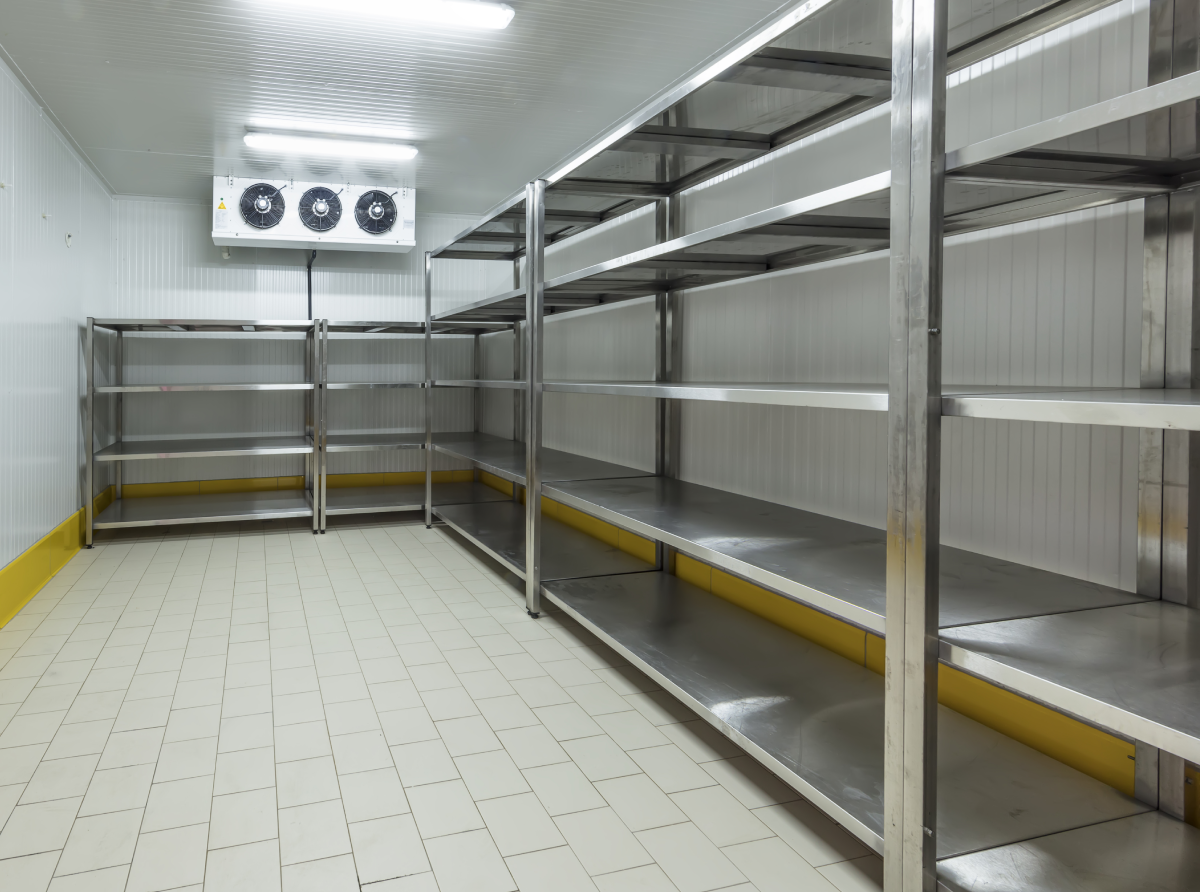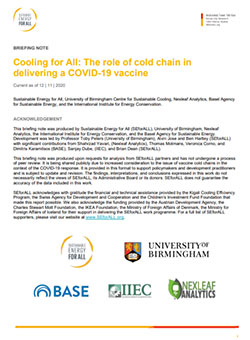The Role of Cold Chain in Delivering a COVID-19 Vaccine

This briefing note "Cooling for All: The role of cold chain in delivering a COVID-19 vaccine" was published in November 2020 and produced by Sustainable Energy for All (SEforALL), University of Birmingham, Nexleaf Analytics, the International Institute for Energy Conservation, and the Basel Agency for Sustainable Energy. Development was led by Professor Toby Peters (University of Birmingham), Alvin Jose, and Ben Hartley (SEforALL) with significant contributions from Shahrzad Yavari, (Nexleaf Analytics), Thomas Motmans, Veronica Corno, and Dimitris Karamitsos (BASE), Sanjay Dube, (IIEC), and Brian Dean (SEforALL).
This briefing note was produced upon requests for analysis from SEforALL partners and has not undergone a process of peer review. It is being shared publicly due to increased consideration of the issue of vaccine cold chains in the context of the COVID-19 response. It is provided in this format to support policymakers and development practitioners and is subject to update and revision. The findings, interpretations, and conclusions expressed in this work do not necessarily reflect the views of SEforALL, its Administrative Board, or its donors. SEforALL does not guarantee the accuracy of the data included in this work.
Introduction
 The SARS-COV-2 (COVID-19) pandemic has had a major impact on international development. Between 71 and 100 million people are likely to be forced into extreme poverty in 2020, the first increase since 1998 and negating gains made since 2017.1 The effects are multidimensional: 121 million additional people face acute food insecurity due to the pandemic; 2 remote learning remains inaccessible to at least 500 million students; 3 and the incomes of 1.6 billion people employed in the informal sector have dropped an estimated 60 percent. 4 Women have experienced 1.8 times more job insecurity than men during the pandemic5 despite representing seven in ten jobs in essential occupations, and many have faced a serious increase in domestic violence since stay-at-home measures were implemented.6
The SARS-COV-2 (COVID-19) pandemic has had a major impact on international development. Between 71 and 100 million people are likely to be forced into extreme poverty in 2020, the first increase since 1998 and negating gains made since 2017.1 The effects are multidimensional: 121 million additional people face acute food insecurity due to the pandemic; 2 remote learning remains inaccessible to at least 500 million students; 3 and the incomes of 1.6 billion people employed in the informal sector have dropped an estimated 60 percent. 4 Women have experienced 1.8 times more job insecurity than men during the pandemic5 despite representing seven in ten jobs in essential occupations, and many have faced a serious increase in domestic violence since stay-at-home measures were implemented.6
Among the impacts of the pandemic are critical disruptions to regular vaccine cold chains, which will be essential to the delivery of a COVID-19 vaccine. Up to 80 million children are at risk of missing out on vaccinations against vaccine-preventable diseases due to COVID-19. These interruptions are primarily due to supply chain disruption, reduced healthcare capacity, and stay-at-home measures.
Cold chains are likely to play a significant role in the delivery of a COVID-19 vaccine. To reach herd immunity (defined as the indirect protection of individuals from an infectious disease when a high proportion of the population is immune) it is estimated that between 60 and 70 percent of the population will need to obtain immunity either through vaccination or the development of antibodies following an infection.7 At present, it is estimated that less than 10 percent of the general population have detectable COVID-19 antibodies, and the longevity of the immune response through infection is unknown. As such it is at minimum a viable possibility that 4.7 to 5.5 billion people (60–70 percent of the global population) will require vaccination to achieve herd immunity. To put the enormity of the challenge into perspective, GAVI vaccination campaigns have reached 760 million people since the year 2000.
There are additional unknown factors pertaining to the vaccine cold chain. These include the temperature sensitivity of the vaccines that will be distributed. Many of the leading vaccine candidates require cold storage at between 2°C and 8°C, while some candidates in Phase 3 trials require storage in temperatures as low as -70°C and -80°C. This includes the first COVID-19 vaccine to announce efficacy results from mass testing which requires cold storage at - 70°C.
Global inequities in terms of vaccine access were already prevalent prior to the pandemic. In 2019, coverage for the vaccine protecting against diphtheria, tetanus, and pertussis (DTP3), which requires storage between 2°C and 8°C, was at 85 percent globally, down slightly from 86 percent in 2018. A total of 85 countries have yet to achieve the targeted vaccination rate of 90 percent for DPT3.
These challenges could be magnified exponentially should a COVID-19 vaccine require consistent cold storage at -70 to -80°C and necessitate a rollout to hundreds of times the population that would typically receive vaccinations in a given year. Most low- and middle-income countries do not have a robust 2°C to 8°C cold chain for existing medical needs or -70 to -80°C cold chains. At a minimum, a COVID-19 vaccine requiring cold storage will require the most significant build-out of cold chains in the developing world ever, and new -70 to -80°C cold chains could be required across low- and middle-income countries. It will be the poor who will face the most significant challenges in accessing a vaccine and delivering sustainable cold chains could become a serious issue of equity that underpins equal and fair access to a COVID-19 vaccine.
Download the Briefing Note: please click here [pdf 638 kb]
